Large (hybrid) bindweed identification and control
Information about the weeds, large (hybrid) bindweed. It is also known by its Latin name Calystegia x lucana (formerly incorrectly recognized as Calystegia silvatica ssp. disjuncta).
About this weed
Large (hybrid) bindweed is a weed of concern in King County. This means due to how widespread it is, property owners are not required to control this species on their property, though it is recommended.
Large (hybrid) bindweed is known as Calystegia x lucana. It is in the morning glory family. It is also known as greater bindweed. It is often confused for the native hedge false bindweed (Calystegia sepium ssp. angulata). Another common name for both species is morning glory.
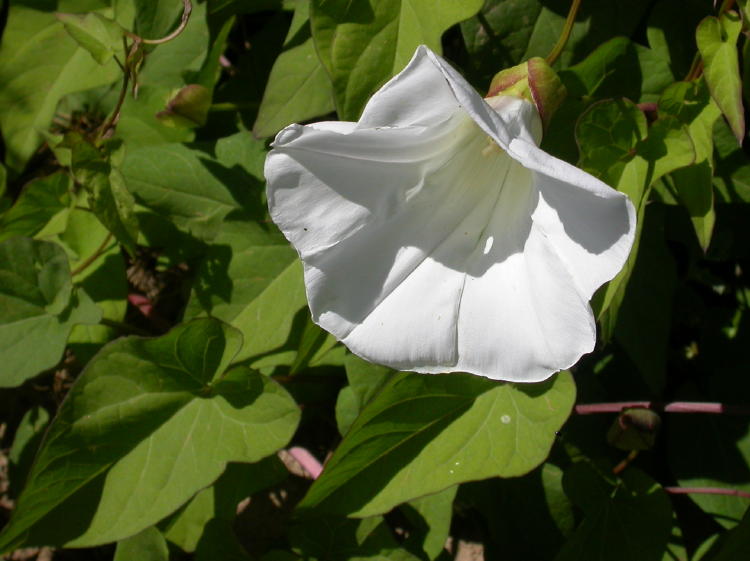
Why it's a problem
Large (hybrid) bindweed is a fast-growing, herbaceous (not woody) vine that crowds out beneficial plants. It also damages them by adding weight and blocking light availability. This plant can reduce years of yield in some crops. It can also increase the time and cost for harvest.
The extensive, spreading rhizomes (root system that spreads outwards and can grow new stems) break apart easily. Each root fragment can create new plants.
Large (hybrid) bindweed likely hybridizes with locally uncommon, native hedge false bindweed (Calystegia sepium ssp. angulata). As a hybrid, this bindweed will continue to mix with the parent large (hybrid) bindweed. A population will eventually inherit the competitive traits and impacts of large (hybrid) bindweed. It will be indistinguishable after a few generations.
Plant description
Large (hybrid) bindweed is a perennial (2+ year life cycle) herbaceous vine. It twines around other vegetation or fences for support and have large, white to pinkish, trumpet-shaped flowers.
Stems are light green to red, slender, twined, branched and mostly hairless. Leaves are variable and are roughly arrowhead-shaped with large rounded or angled basal lobes that also vary in size and width. The sinuses (space between the lobes at the bottom) are variable and may be wider/u-shaped, or more angled/v-shaped.
Two large green leafy bracteoles (modified leaves) are found at the base of each flower. How far the bracts overlap and cover the sepals (leaflike flower part that encloses/supports the petals) help distinguish it from native hedge false bindweed (no overlap).
Below ground the plants have extensive, white fleshy rhizomes and fibrous roots that may extend into the ground up to 10 feet. It is a common weed especially in developed areas, farms, shorelines, riparian areas, restoration areas and vacant lands.
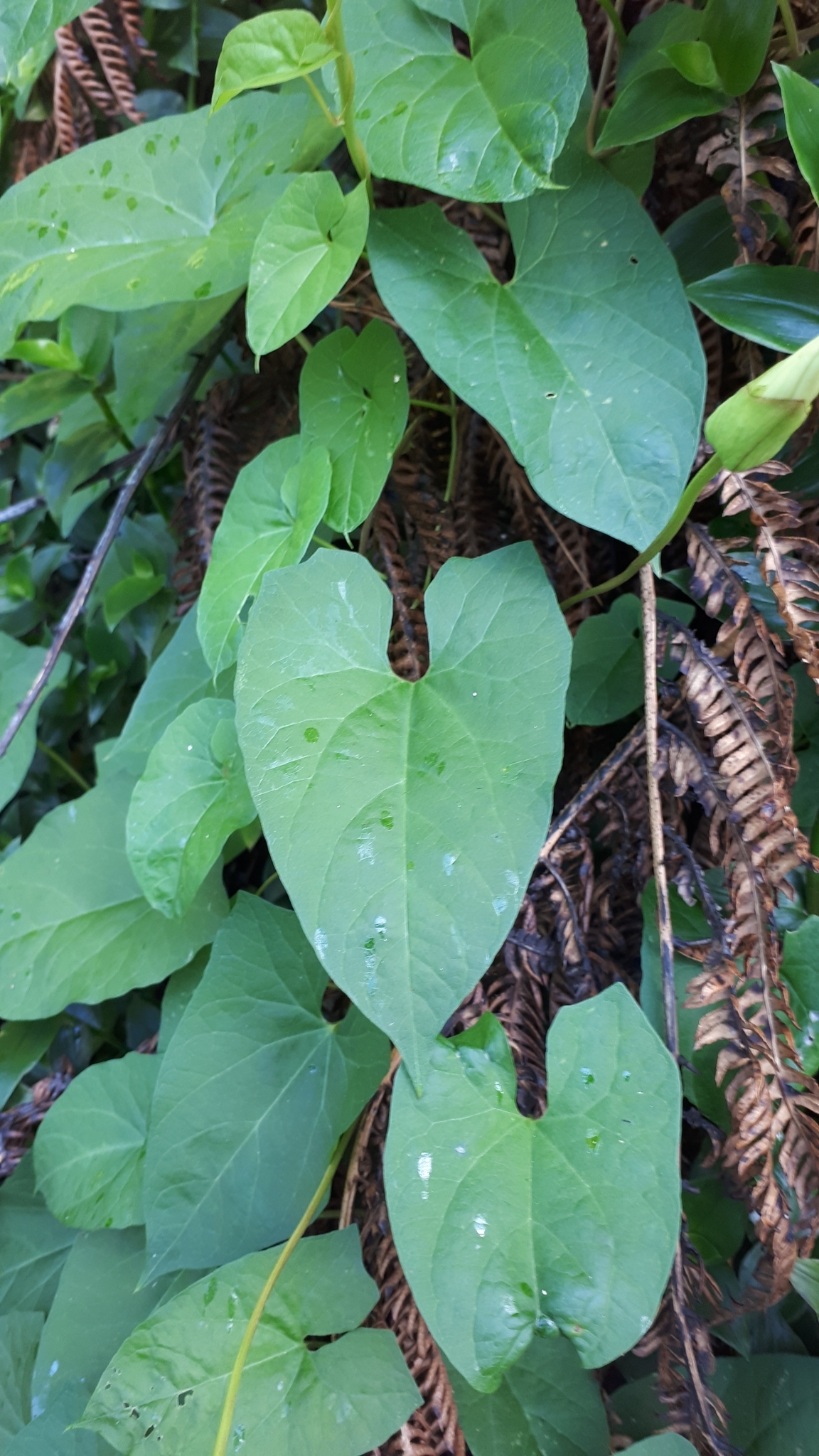
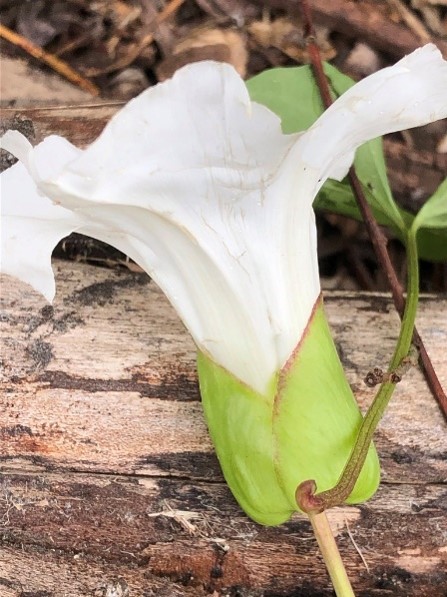
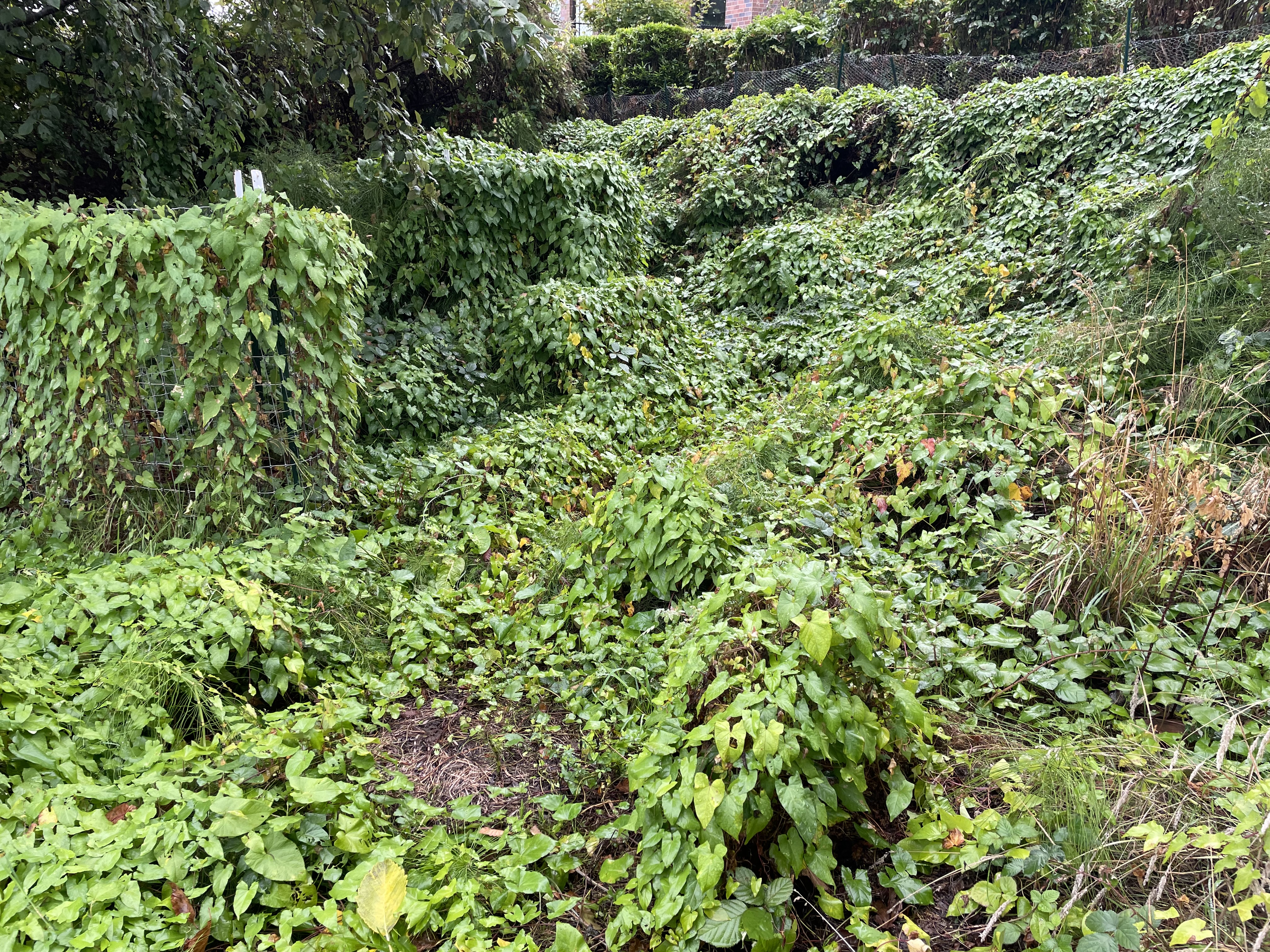
Be aware of look-alike plants
The Flora of the Pacific Northwest was updated in 2018 and separated out the native and large (hybrid) bindweed.
Hedge false bindweed - native plant
Hedge false bindweed (Calystegia sepium) is a native plant that closely resembles large (hybrid) bindweed. Compared to large (hybrid) bindweed, hedge false bindweed has a smaller flower, its base tapers below the flower, its angled bracteoles (modified leaves, pictured below) do not overlap, its leaves are smaller, and the space between the angular lobes at the base of the leaves is more narrow (v-shaped) and the lobes do not overlap. This plant also generally has a later bloom time (late summer).
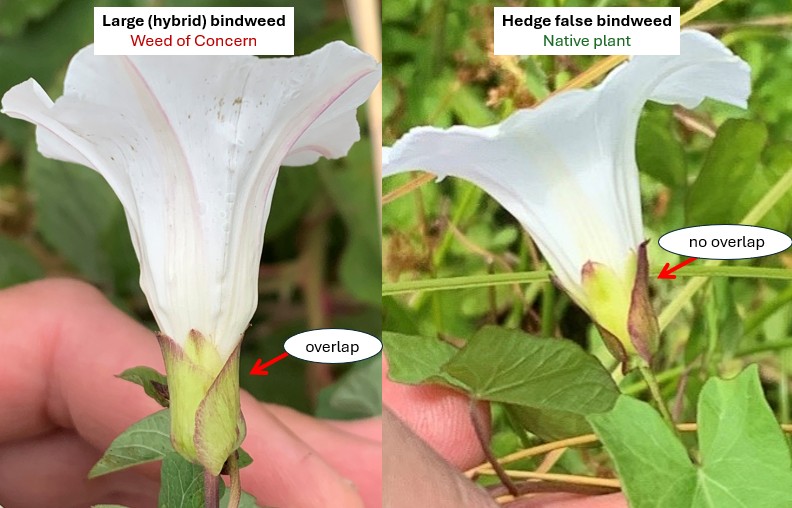
Field bindweed - Class C Noxious Weed
Field bindweed (Convolvulus arvensis) is a noxious weed that closely resembles large (hybrid) bindweed. Compared to large (hybrid) bindweed, its leaves and flowers are smaller, and it tends to grow along the ground instead of climbing. It is a very problematic noxious weed in many crops.
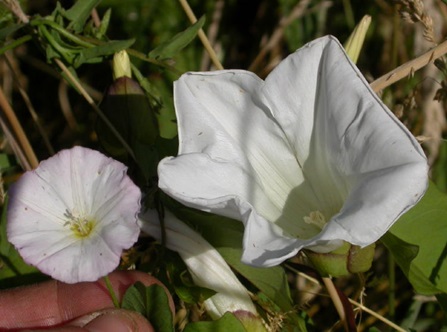
When in doubt, take photos of the flowering parts (especially the bracteoles [modified leaves at base of the flower]) and report them on iNaturalist.
What to do if you find it
A long-term management strategy that promotes the growth of desirable plants is the most effective method of controlling introduced bindweeds. Be sure to monitor the area for resprouts and seedlings after plants are removed.
Because introduced bindweeds are so widespread, property owners in King County are not required to control it. King County is not generally tracking infestations. We can provide advice on how to control bindweeds but there is generally no legal requirement to do so. The King County Noxious Weed Control Board recommends control of large (hybrid) bindweed where natural resources are being protected or as part of a stewardship plan. It may be difficult to distinguish large (hybrid) bindweed from King County’s native hedge false bindweed.
Control methods
We recommend using a combination of methods to control weeds. Prevention is the most effective bindweed control. Identify introduced bindweeds using the tools and techniques addressed below. In areas with few weeds, it is important to act quickly before they become harder to control. Make a long-term plan as it often takes several years to get rid of most weeds. Start in the least infested areas first and then move into more heavily infested areas.
Manual control
Carefully dig out plants, removing as much of the rhizomes as possible. Pulled plant parts can also be piled up on an elevated surface and dried out. Flowering and seeding plant parts should be bagged and put in the garbage.
Cultural control
Depleting the energy reserves of the roots over multiple seasons can help with control of introduced bindweeds. Establishing dense tree or shrub layers will eventually weaken bindweed populations. This will increase the effectiveness of other control methods. Grass or lawn sod layers with regular mowing and a bagged mower (to prevent distribution of vegetative plant parts) will also outcompete bindweed root systems over time.
Chemical control
Stay safe when using herbicide:
- Always read the label before use.
- Wear appropriate personal protective equipment (PPE).
- Follow state and local regulations.
A systemic herbicide can effective against bindweeds. Addressing the roots and rhizomes is a critical part of its control. Larger patches most likely will need an herbicide treatment in combination with other control methods to be effective.
Avoid spraying where herbicide may enter a waterway or wetland unless you are using a state-approved aquatic herbicide and have the required permits and licenses to do so. Use of pesticides in water is regulated in Washington state. See Washington Department of Ecology Aquatic Pesticide Permits for details. Always read the label before using herbicide and follow state and local regulations.
Spot treatments with combinations of triclopyr/picloram/aminopyralid, aminopyralid by itself, or glyphosate have been effective in summer or fall. The best time is before seed set in summer.
For large infestations, consider combining methods. Hand-pulling and the use of competitive beneficial plants in tandem will use less herbicide. Reduce bindweed cover before herbicide use by hand-pulling. Spray regrowth low to the ground so as not to damage nearby beneficial plants.
Always monitor sites for any plants that resprout and need follow up treatment. For more specific herbicide recommendations, see the link to Susceptibility of great bindweed to herbicides, produced by Massey University in New Zealand.
For more information or a site-specific control recommendation in King County, contact the noxious weed program. For information in other counties in Washington state, contact your local weed board or your local cooperative extension office.
Disposal instructions
Bag and dispose of all bindweed debris as plant fragments (especially roots) resprout when in contact with the ground to form new plants. Bindweeds are most commonly spread via rhizome fragments when yard waste is dumped and not disposed of properly.
Washington State Noxious Weed Control Board pamphlet on noxious weed disposal
 Translate
Translate